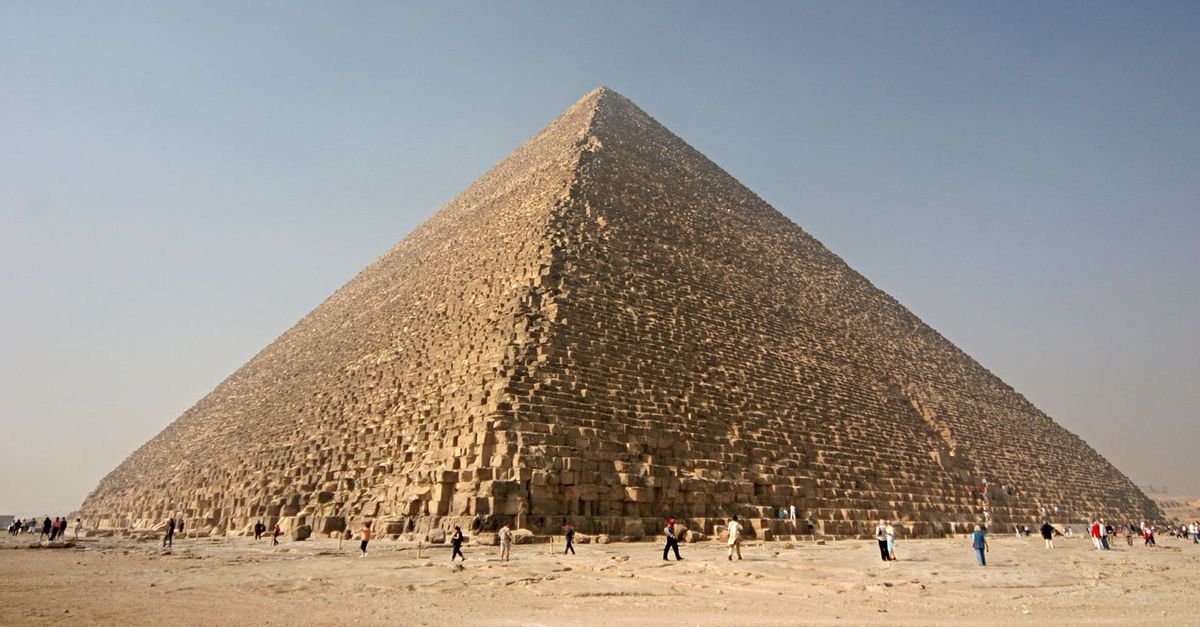There is NO evidence that the Hebrews were ever in Egypt.
Live Science
Who built the Egyptian pyramids?
Owen Jarus 3 hrs ago
Egypt's pyramids are an archaeological marvel, rising high above the desert sands and visible for miles on end. Building these pyramids was undoubtedly a mammoth task, so who were the individuals that pulled it off?
a man riding a horse in a desert with Great Pyramid of Giza in the background: A Bedouin on a camel by the Pyramids of Khafre and Menkaure at the Giza Necropolis in Egypt.© Provided by Live Science A Bedouin on a camel by the Pyramids of Khafre and Menkaure at the Giza Necropolis in Egypt.
There are many theories about who built Egypt's pyramids, including large teams of enslaved Jewish people and wilder ideas, such as inhabitants of the 'lost' city of Atlantis or even aliens.
None of these theories, however, have evidence to back them up.
The pyramids could not have been constructed by Jewish slaves, as no archaeological remains that can be directly linked to the Jewish people have been found in Egypt that date back to 4,500 years ago, when the Giza pyramids were built, archaeological research has revealed. Additionally the story told in the Hebrew Bible about Jews being slaves in Egypt refers to a city named "Ramesses." A city named pi-Ramesses was founded during the 19th dynasty (about 1295-1186 B.C.) and was named after Ramesses II, who ruled 1279–1213 BC. This city was constructed after the era of pyramid construction had ended in Egypt.
"We have no clue, not even a single word, about early Israelites in Egypt: neither in monumental inscriptions on walls of temples, nor in tomb inscriptions, nor in papyri," wrote archaeologists Israel Finkelstein and Neil Asher Silberman in their book "The Bible Unearthed: Archaeology's New Vision of Ancient Israel and the Origin of its Sacred Texts" (The Free Press, 2001).
What's more, no archaeological evidence has ever been found for the lost city of Atlantis in any time period, and many scholars believe that the story is fictional. As for aliens, well, that idea is out of this world.
In fact, all the evidence shows that the ancient Egyptians built the pyramids, Egyptologists say. But how the pyramid builders lived, how they were compensated and how they were treated is a mystery that researchers are still investigating.
The pyramids and their builders
Egypt has more than 100 ancient pyramids, but its most famous include the first step pyramid, built during the reign of the pharaoh Djoser (about 2630-2611 B.C.), and the first true pyramid — one that has smooth sides — built under the rule of pharaoh Snefru (about 2575-2551 B.C.), Mark Lehner wrote in his book, "The Complete Pyramids: Solving the Ancient Mysteries" (Thames & Hudson, 2008). The Great Pyramid was constructed at Giza during the reign of pharaoh Khufu (about 2551-2528 B.C.), and two of his successors, Khafre (about 2520-2494 B.C.) and Menkaure (about 2490-2472 B.C.), also had pyramids built at Giza.
Pharaohs gradually stopped building pyramids during the New Kingdom (1550-1070 B.C.), choosing instead to be buried in the Valley of the Kings, which is located about 300 miles (483 km) south of Giza, Lehner noted in his book. Over the past few decades, archaeologists have found new pieces of evidence that provide clues as to who the pyramid builders were and how they lived.
Surviving writteasimes translated as "gangs" — helped bring material to Giza. The papyri found at Wadi al-Jarf tell of a group of 200 men headed by an inspector named Merer. The group of workers transported limestone by boat along the Nile River a distance of about 11 miles (18 kilometers) from Tura to the Great Pyramid, where the stone was used to build the outer casing of the monument.
In the past, Egyptologists had theorized that the pyramid builders were largely made up of seasonal agricultural workers who had reached a point in the year in which there was little agricultural work to be done. However, it remains to be seen whether this is actually true. The papyri detailing the pyramid's histories are still in the process of being deciphered and analyzed, but the results indicate that the gang led by Merer did far more than help with pyramid construction.
blog.world-mysteries.com

www.goldennumber.net

www.snopes.com


